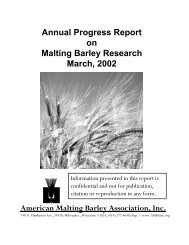Annual Progress Report on Malting Barley Research March, 2007
Annual Progress Report on Malting Barley Research March, 2007
Annual Progress Report on Malting Barley Research March, 2007
Create successful ePaper yourself
Turn your PDF publications into a flip-book with our unique Google optimized e-Paper software.
Preliminary <strong>Malting</strong> <strong>Barley</strong> Yield Trials at the Osnabrock and Ness<strong>on</strong> Valley research<br />
sites.<br />
Early Generati<strong>on</strong> Selecti<strong>on</strong>s<br />
Single spikes from the F3 and F4 generati<strong>on</strong>s were sown at the Osnabrock and Ness<strong>on</strong><br />
Valley research locati<strong>on</strong>s. About 8,600 head rows representing material from 74<br />
crosses were sown. Selecti<strong>on</strong> of head rows in the field was based <strong>on</strong> maturity, plant<br />
height, straw strength, kernel plumpness, kernel color, FHB resistance, awn type, spike<br />
length, spike erectness, and spike density. About 2,100 selecti<strong>on</strong>s were made and<br />
submitted to Dr. Paul Schwarz’s laboratory (Dept. of Plant Sciences) for malt quality<br />
predicti<strong>on</strong> tests. Selecti<strong>on</strong>s were evaluated for barley kernel assortment, barley grain<br />
protein, test weight, and kernel color. Spikes from the selected rows were sown in<br />
Yuma, AZ to increase seed for <strong>2007</strong> yield trials. Rows from the selecti<strong>on</strong>s with the best<br />
malt quality estimates, and acceptable straw strength, maturity, and uniformity will be<br />
harvested and advanced to the Preliminary <strong>Malting</strong> <strong>Barley</strong> Yield Trials.<br />
One-hundred three F2 populati<strong>on</strong>s were grown at the Osnabrock and Ness<strong>on</strong> Valley<br />
research locati<strong>on</strong>s. Selecti<strong>on</strong> am<strong>on</strong>g and within populati<strong>on</strong>s was based <strong>on</strong> the same<br />
criteria used in the F3 and F4 progeny rows. Thirty-seven F1 populati<strong>on</strong>s from crosses<br />
made in the 2006-spring greenhouse were grown in the field at Ness<strong>on</strong> Valley. Onehundred<br />
thirty-two crosses were made during fall of 2006 in the greenhouse to combine<br />
favorable agr<strong>on</strong>omic characteristics, disease resistance, and malt quality traits. Over<br />
50% of the crosses made used parents that showed resistance to FHB and/or septoria<br />
speckled leaf blotch.<br />
Breeding for Fusarium Head Blight Resistance<br />
Since the incepti<strong>on</strong> of our work <strong>on</strong> breeding for FHB resistance, a main objective has<br />
been to transfer FHB-resistance from unadapted resistant accessi<strong>on</strong>s to our elite<br />
Midwest six-rowed malting barley germplasm. In 2006, 391 of the 729 lines we<br />
evaluated in replicated yield trials came from our FHB-resistance breeding project. In<br />
<strong>2007</strong> the percentage of lines from this breeding project will c<strong>on</strong>tinue to increase. For<br />
example, 15 of the 20 experimental lines in our <strong>2007</strong> Advanced Yield Trial (AYT) will<br />
come from our FHB-resistance breeding project. This AYT is very important since it is<br />
the source of parents that will be used for the <strong>2007</strong> fall crossing block and the source of<br />
lines for entry in the 2008 AMBA Pilot Scale Evaluati<strong>on</strong> Program.<br />
A limitati<strong>on</strong> in our effort to develop FHB-resistant varieties is the well documented<br />
linkage block near the centromeric regi<strong>on</strong> of chromosome 2H that is found in most of<br />
the resistant accessi<strong>on</strong>s. The linkage block includes loci c<strong>on</strong>trolling FHB resistance,<br />
DON accumulati<strong>on</strong>, heading date, plant height, and maturity. This linkage block helps<br />
to explain our inability to identify progeny from crosses to FHB-resistant lines that have<br />
acceptable plant height, even in F2 populati<strong>on</strong>s with > 15,000 plants. A strategy we are<br />
using to overcome the negative linkages in chromosome 2H is to c<strong>on</strong>trol plant height<br />
and maturity using genes from outside the critical regi<strong>on</strong>. For example, parents<br />
c<strong>on</strong>taining the sdw1 gene in chromosome 3H were crossed to tall FHB resistant lines as<br />
a means for reducing plant height in FHB resistant progeny. About 36% of the<br />
57
















